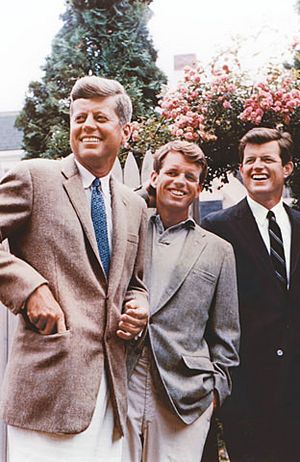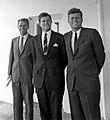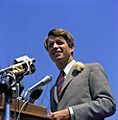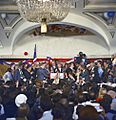Robert F. Kennedy facts for kids
Quick facts for kids
Robert F. Kennedy
|
|
|---|---|
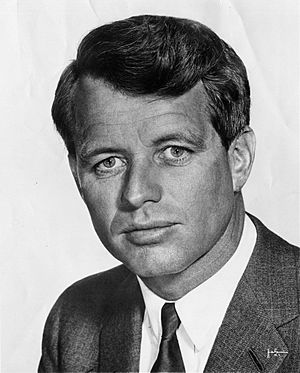
Official portrait, c. 1965
|
|
| United States Senator from New York |
|
| In office January 3, 1965 – June 6, 1968 |
|
| Preceded by | Kenneth Keating |
| Succeeded by | Charles Goodell |
| 64th United States Attorney General | |
| In office January 21, 1961 – September 3, 1964 |
|
| President | |
| Deputy | |
| Preceded by | William P. Rogers |
| Succeeded by | Nicholas Katzenbach |
| Personal details | |
| Born |
Robert Francis Kennedy
November 20, 1925 Brookline, Massachusetts, U.S. |
| Died | June 6, 1968 (aged 42) Los Angeles, California, U.S. |
| Cause of death | Assassination |
| Resting place | Arlington National Cemetery |
| Political party | Democratic |
| Spouse | |
| Children |
|
| Parents | |
| Relatives | Kennedy family |
| Education |
|
| Signature | |
| Military service | |
| Branch/service | U.S. Naval Reserve |
| Years of service | 1944–1946 |
| Rank | Seaman apprentice |
| Unit | USS Joseph P. Kennedy Jr. |
| Battles/wars | World War II |
Robert Francis Kennedy (November 20, 1925 – June 6, 1968) was an American lawyer and politician. People also knew him as RFK or Bobby. He served as the 64th United States Attorney General from 1961 to 1964. Later, he became a U.S. Senator for New York from 1965 until his death in 1968.
Like his brothers John and Edward, Bobby was an important member of the Democratic Party. Many people see him as a symbol of modern American liberalism, which focuses on social justice and equality.
Contents
Early Life and Education
Robert Francis Kennedy was born on November 20, 1925, in Brookline, Massachusetts. This town is just outside Boston. He was the seventh of nine children. His father, Joseph P. Kennedy Sr., was a wealthy businessman and politician. His mother, Rose Fitzgerald Kennedy, was known for her charity work.
His parents came from well-known Irish-American families in Boston. Bobby had eight siblings: Joseph Jr., John, Rosemary, Kathleen, Eunice, Patricia, Jean, and Ted. All his grandparents were children of Irish immigrants.
Bobby's father, Joe Sr., had big political dreams. He hoped one of his sons would become president. At first, he hoped for his oldest son, Joseph Jr. After Joseph Jr. died in World War II, his hopes turned to John.
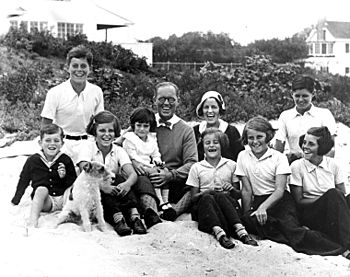
Bobby's older brother John was often sick. Because of this, John loved to read many books. Even though they weren't very close as kids, John would take Bobby on walks. He would tell him exciting stories about heroes and adventures from his books. They both loved the author John Buchan, who wrote The Thirty-Nine Steps.
As a child, Bobby went to many different schools. This meant he often had to make new friends. In 1938, he sailed to London with his mother and four younger siblings. They joined his father, who was serving as the Ambassador to the United Kingdom. Bobby attended the Gibbs School for Boys for seventh grade. He returned to the United States just before World War II started in Europe.
In September 1939, Bobby began eighth grade at St. Paul's School. This was an elite private school for boys in Concord, New Hampshire. His father liked this school.
After two months, his mother took him out of St. Paul's. She enrolled him in Portsmouth Priory School. This was a Catholic boarding school for boys in Portsmouth, Rhode Island. Bobby attended Portsmouth for eighth through tenth grade.
In September 1942, Bobby transferred to his third boarding school, Milton Academy. This school was in Milton, Massachusetts. He went there for 11th and 12th grades. His father wanted him to go to Milton because he believed it would prepare him better for Harvard.
Military Service and College
In 1943, six weeks before his 18th birthday, Bobby joined the United States Naval Reserve. He started as a seaman apprentice.
He left active duty in March 1944. He left Milton Academy early to join the V-12 Navy College Training Program at Harvard College. This was in Cambridge, Massachusetts.
On December 15, 1945, the U.S. Navy launched a destroyer ship. It was named USS Joseph P. Kennedy Jr., after Bobby's older brother who died in the war. Bobby asked to leave his officer training so he could serve on this ship. On May 30, 1946, he received an honorable discharge from the Navy. For his service, he earned the American Campaign Medal and the World War II Victory Medal.
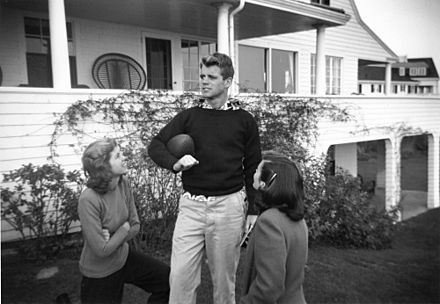
In September 1946, Bobby started at Harvard as a junior. He got credit for his time in the V-12 program. He graduated from Harvard in 1948 with a bachelor's degree in political science.
In September 1948, he enrolled at the University of Virginia School of Law. He graduated from law school in June 1951.
Career Highlights
Bobby started his career as a reporter for The Boston Post. He also worked as a lawyer at the Justice Department. Later, he left to help his brother John's successful campaign for the U.S. Senate in 1952. The next year, he worked for a Senate committee led by Senator Joseph McCarthy.
He became well-known as the chief lawyer for the Senate Labor Rackets Committee from 1957 to 1959. Bobby left this committee to manage his brother John's successful campaign for president in 1960. He was then appointed United States Attorney General at age 35. This made him one of the youngest cabinet members in American history. He was his brother's closest advisor until John's assassination in 1963.
Bobby is remembered for supporting the civil rights movement. He also fought against organized crime and the Mafia. He was involved in U.S. foreign policy, especially concerning Cuba.
After his brother's death, he stayed in his job for several months during the Presidency of Lyndon B. Johnson. He then decided to run for the United States Senate from New York in 1964. He won against the Republican Senator Kenneth Keating.
As a Senator, Bobby spoke out against the U.S. being involved in the Vietnam War. He also worked to bring attention to poverty. He was a strong supporter of human rights and social justice. He traveled to other countries and worked with leaders like Martin Luther King Jr., Cesar Chavez, and Walter Reuther.
In 1968, Bobby became a leading candidate for president. He was popular with poor people, African Americans, Hispanic people, Catholics, and young voters. His main opponent was Senator Eugene McCarthy.
His Death
After winning the California primary election, Bobby was shot. This happened just after midnight on June 5, 1968. He was shot by Sirhan Sirhan, a 24-year-old Palestinian man. Sirhan said he did it because Bobby supported Israel after the 1967 Six-Day War. Bobby died 25 hours later. Sirhan was arrested and found guilty.
Bobby's body was taken to Saint Patrick's Cathedral in New York City. Many people came to pay their respects. A special funeral service was held there on June 8. Members of the Kennedy family, President Lyndon B. Johnson, and his wife Lady Bird Johnson attended.
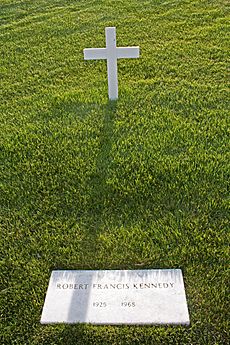
After the service, Bobby's body was taken by a special train to Washington, D.C. Thousands of people stood along the tracks to honor him as the train passed.
Bobby was buried near his brother John at Arlington National Cemetery in Arlington, Virginia. This is just across the Potomac River from Washington, D.C. Although he had wanted to be buried in Massachusetts, his family felt he should be next to his brother in Arlington.
On June 9, President Lyndon B. Johnson ordered security for all U.S. presidential candidates. He also declared a national day of mourning. After Bobby's death, the U.S. Secret Service was given the job of protecting presidential candidates.

Family Life
On June 17, 1950, Bobby married Ethel Skakel. She was the daughter of businessman George and Ann Skakel. They were married at St. Mary's Catholic Church in Greenwich, Connecticut. Bobby and Ethel had 11 children:
| Name | Life | Marriage and children |
|---|---|---|
| Kathleen Hartington Kennedy | July 4, 1951 | Married David Townsend in 1973; four daughters. |
| Joseph Patrick Kennedy | September 24, 1952 | Married Sheila Brewster Rauch (1979-1991); had two sons; Married Anne Kelly in 1993. |
| Robert F. Kennedy Jr. | January 17, 1954 | Married three times; first to Emily Black (1982-1994) and had two children; then to Mary Kathleen Richardson (1994-2012) and had four children; Married thirdly to Cheryl Hines in 2014. |
| David Anthony Kennedy | June 15, 1955 - April 25, 1984 | Never married, no children. Died in 1984. |
| Mary Courtney "Courtney'" Kennedy | September 9, 1956 | Married to Jeffrey Ruhe (1980-1990); Married Paul Michael Hill in 1993; one daughter, Saoirse Rosin Hill (1997-2019). |
| Michael LeMoyne Kennedy | February 27, 1958 - December 31, 1997 | Married Victoria Denise Gifford in 1981; had three children. Died in skiing accident. |
| Mary Kerry "Kerry" Kennedy | September 8, 1959 | Married Andrew Cuomo in 1990; had three daughters; divorced in 2005. |
| Christopher George "Chris" Kennedy | July 4, 1963 | Married Sheila Sinclair-Berner in 1987; one son and three daughters. |
| Matthew Maxwell "Max" Taylor Kennedy | January 11, 1965 | Married Victoria Anne Strauss in 1991; three children. |
| Douglas Harriman Kennedy | March 24, 1967 | Married Molly Stark in 1998; five children. |
| Rory Elizabeth Katherine Kennedy | December 12, 1968 | Born after Kennedy's death. Married Mark Bailey in 1999; they have three children. |
Bobby owned a home at the famous Kennedy compound in Hyannis Port, Massachusetts. But he spent most of his time at his estate called Hickory Hill in McLean, Virginia. This was west of Washington, D.C. His wife, Ethel, and their children continued to live there after he died. Ethel Kennedy sold Hickory Hill in 2009.
His Personality
People said Bobby was the gentlest and shyest of his family. He was also the least talkative. When he was a young boy, his grandmother worried he might be too soft. His mother also worried because he was the "smallest and thinnest." But they soon found out there was "no fear of that."
A family friend, Lem Billings, met Bobby when he was eight. Billings later said he loved Bobby, calling him "the nicest little boy I ever met." He also said Bobby was hardly noticed early on because "he didn't bother anybody." Luella Hennessey, who became the children's nurse when Bobby was 12, called him "the most thoughtful and considerate" of his siblings.
His siblings often teased him, as joking was common in their family. Bobby would either make jokes about himself or stay quiet. Even though he was gentle, he could speak his mind. Once, he argued with a priest in public, which shocked his mother. She later admitted he had been right all along. Even when fighting for a good cause, his comments could be "cutting."
Bobby's father had big dreams for his older brothers. But Bobby always showed strong loyalty to his family. His father and older brothers admired his competitive spirit. His loyalty made them feel even closer to him.
As a child, he was quite timid. His father's strong personality often made him a target. When working on his older brother John's campaigns, Bobby was more involved and determined than John himself. He paid close attention to every detail and fought every battle. He had always been closer to John than to other family members.
Legacy and Honors
Bobby Kennedy is remembered for his great speaking skills. He was also good at bringing people together. His death was a big blow to the hope for a better future. Many Americans felt this hope during the difficult 1960s.
Many believe Bobby's death was a major reason the Democratic Party lost the 1968 presidential election. Since he passed away, Bobby has been respected by both liberals and conservatives.
Bobby's ideas about using government power to help people who are less fortunate became very important to American liberalism. This is part of the "Kennedy legacy."
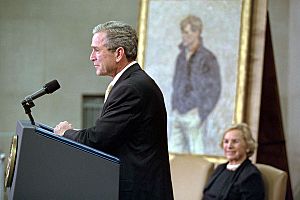
After Bobby Kennedy's death, many roads, schools, and other places were named after him.
The Robert F. Kennedy Center for Justice and Human Rights was started in 1968. It gives awards to people who work for human rights around the world.
The sports stadium in Washington, D.C., was renamed Robert F. Kennedy Memorial Stadium in 1969.
In 1978, the United States Congress gave Bobby the Congressional Gold Medal. This is a high honor for special service.
On January 12, 1979, the U.S. Postal Service released a 15-cent stamp honoring RFK. Over 159 million of these blue-and-white stamps were printed. The stamp's design came from a family photo suggested by his wife, Ethel.
In 1998, the United States Mint released the Robert F. Kennedy silver dollar. This special coin had Bobby's picture on one side. On the other side were symbols of the United States Department of Justice and the United States Senate.
On November 20, 2001, U.S. President George W. Bush and Attorney General John Ashcroft dedicated the Department of Justice headquarters building in Washington, D.C. They named it the Robert F. Kennedy Department of Justice Building. This honored Bobby on what would have been his 76th birthday. Both spoke at the ceremony, as did Bobby's oldest son, Joseph.
| Robert F. Kennedy silver dollar | |
|---|---|
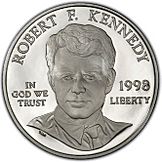 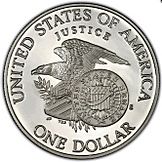 |
|
| Obverse | Reverse |
| Proof Robert F. Kennedy silver dollar | |
In 1969, a group of people started the Robert F. Kennedy Children's Action Corps. This group helps over 800 abused and neglected children each year.
A statue of Bobby is in the library of the University of Virginia School of Law. This is where he earned his law degree.
On June 4, 2008, the New York State Assembly voted to rename the Triborough Bridge in New York City. It became the Robert F. Kennedy Memorial Bridge. New York State Governor David Paterson signed this into law on August 8, 2008. The bridge is now often called the RFK-Triborough Bridge.
On September 20, 2016, the United States Navy announced they would name a refueling ship after Kennedy. Members of his family attended the ceremony.
Personal items and documents from his office are on display. You can see them in a special exhibit at the John F. Kennedy Library and Museum. Papers from his time as attorney general, senator, and activist are also there.
The Robert F. Kennedy Assassination Archives were started in 1984. They are stored at the University of Massachusetts Dartmouth. They contain many government documents, photos, and interviews. These materials were gathered by journalists and others who looked into the case.
Kennedy and Martin Luther King Jr.
Several public places honor both Kennedy and Martin Luther King Jr..
- In 1969, Woodrow Wilson Junior College in Chicago was renamed Kennedy–King College.
- In 1994, the city of Indianapolis built the Landmark for Peace Memorial. It is near the spot where Bobby gave his famous speech on the night King died. The monument shows sculptures of RFK and King reaching out to each other. This symbolizes their efforts to bring different races together. A historical marker is also at the site.
In 2019, Bobby Kennedy's "Speech on the Death of Dr. Martin Luther King, Jr." was chosen by the Library of Congress. It was added to the National Recording Registry. This means it is considered "culturally, historically, or aesthetically significant."
In Movies and TV
Bobby Kennedy has been featured in many documentaries. He has also appeared in popular movies and TV shows. His role in the Cuban Missile Crisis was shown in the TV play The Missiles of October (1974). Martin Sheen played him in that show. Steven Culp played him in Thirteen Days (2000).
The movie Bobby (2006) tells the stories of several people leading up to his assassination. The film uses real footage from his presidential campaign. Dave Fraunces briefly plays him. Barry Pepper won an Emmy Award for playing Kennedy in The Kennedys (2011). This was an 8-part TV series. Peter Sarsgaard plays him in the movie about Jacqueline Kennedy, Jackie (2016). Jack Huston plays him in Martin Scorsese's film The Irishman (2019).
Interesting Facts About Robert Kennedy
- As a child, he loved American history. He decorated his bedroom with pictures of U.S. presidents.
- The young Bobby was a keen stamp collector. He once received a handwritten letter from President Franklin Roosevelt, who also collected stamps.
- At school, he was an average student. He even had to repeat third grade.
- In April 1939, he gave his first public speech. It was at the opening of a youth club in England.
- At Harvard, he played on the varsity football team as an end.
- Kennedy wrote a book about the Cuban Missile Crisis. It was called Thirteen Days.
- He was a very religious Catholic throughout his life.
- Bobby was the first brother of a U.S. president to serve as the U.S. Attorney General.
Images for kids
-
Ambassador Joseph Kennedy Sr. visits his sons (Robert, second from right) in Boston c. 1939
-
Kennedy (second from left) during his time at Bates College, in front of a snow replica of a Navy boat.
-
Kennedy with David Dubinsky, attending a 1964 (precise date unknown) Lyndon B. Johnson election campaign event. The sign in the background reads, "For President – Lyndon B. Johnson".
-
Pelé and Kennedy shaking hands after a game at Maracanã Stadium, Rio de Janeiro
-
Senator Robert F. Kennedy and President Lyndon B. Johnson in the Oval Office, 1966
-
Kennedy delivers remarks to a crowd in the Ambassador Hotel moments before the assassination, June 5, 1968
See also
 In Spanish: Robert F. Kennedy para niños
In Spanish: Robert F. Kennedy para niños
- Kennedy family tree
- List of assassinated American politicians
- List of peace activists
- List of United States Congress members who died in office (1950–99)


